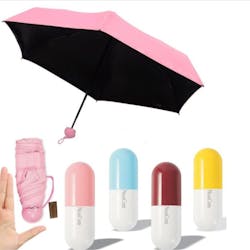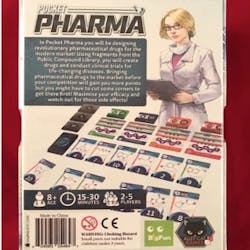I recently came across a 2019 STEM Toy Gift Guide, courtesy of our sister publication, Chemical Processing.
There were some pretty cool options on the list, however, I found the suggestions overly heavy in the math and engineering categories, and lacking in the areas of science and pharma. So, as a fan of both pharma and spending money, I've decided to devise my own list for the entertainment of Pharma Manufacturing readers.
Disclaimer:
Statements regarding gifts have not been evaluated by the FDA nor the editors of Pharma Manufacturing. Our gift guide is not intended to diagnose, treat, cure, or prevent any health condition.
Drug capsule umbrellas
Lightweight and offered in multiple colors. Sure to cure your rainy-day blues!
Drug capsules, like their umbrella accessories, provide a number of advantages over other dosage forms, including ease of storage, portability and ease of use. While it is true that the pharma pipeline is monopolized by new biologic hopefuls implementing novel scientific approaches such as gene therapies, small molecule drugs still dominate the U.S. market in terms of quantity.
Read more about solid dose trends here
Drug discovery board game
When it comes to new drugs, speed to market is critical. The pressure to discover promising new treatment options, like immunotherapy or precision medicine, to address the 18 million new cases of cancer the World Health Organization is estimating for this year has pharma companies racing against the clock. The high cost of these drugs has developers pursuing lower-cost treatments and generic alternatives to brand name drugs. To produce a lower costing drug, pharma companies need to boost laboratory efficiency and cut costs. At the core of this initiative lies automation.
Read more about how automation can speed products to market here
Plush Actos beanbag
But buyer beware: In 2011, the FDA added a warning about the increased risk for bladder cancer to the Actos (pioglitazone) label. After analyzing new studies, the agency again concluded in 2016 that pioglitazone may be linked to an increased risk for bladder cancer and updated the drug's label to describe the additional studies that were reviewed. To date, thousands of lawsuits had been filed against Takeda regarding Actos.
Read more about Actos' bladder cancer warnings here
Pharmaceutical drug analysis bedding set
Nothing helps the industry sleep sounder at night like knowing they are producing high quality drugs. With a duvet cover, flat sheet and two pillowcases, you can rest assured knowing you have multiple layers of drug analysis.
Broadly speaking, pharmaceutical analysis is the application of a process in order to identify a drug in its bulk or final dosage form. Testing drug products involves chemical, physical and microbiological analysis. New advances in the analytical technologies used for routine workflows are helping to support the efficient manufacture and release of high-quality biotherapeutics in line with regulatory requirements. Here, we highlight how advances in biopharmaceutical characterization technologies are helping manufacturers to efficiently and effectively monitor CQAs and deliver safe, high-quality medicines to patients.
Read more about advances in analytical monitoring here
“Cute” pharmaceutical backpack
Joking aside, the importance of education can't be stressed enough in the pharma industry. As more highly complex therapies are approved and race towards commercialization, biopharma needs to have a properly trained workforce in place. Traditional training methods are one-dimensional and simply not producing biopharma workers who can “hit the plant floor running.” With help from academia, the biopharma industry is at long last beginning to address this problem and subsequently rethink workforce training — but is this paradigm shift happening fast enough to keep pace with biopharma’s progress?
Read more about biopharma workforce training here
Plush happy pill
While there is no such thing as a "happy pill," this year saw advancements in depression medication. For the first time in decades, a fundamentally new drug became available for people with severe depression. In March, the U.S. FDA approved Johnson & Johnson's controversial Spravato, a nasal spray for depression. The spray offers a new option for treating people whose depression hasn’t responded to other approaches. However, the treatment includes a compound similar to ketamine, an often-abused "party" drug that can induce sedation and a trance-like state. But J&J’s treatment is believed to restore nerve cell connections that improve depression symptoms. Many said the drug could be a “game-changer” for depression patients.
Read more about Spravato's approval here
DNA strand throw pillow
Scientists have been tinkering with ways to cure diseases by targeting genes for the last four decades. On the heels of the development of recombinant DNA technology, a seminal research paper emerged in 1972 which laid out a groundbreaking idea for treating genetic disorders by introducing functional DNA into a patient. It took 20 years of additional research before the idea became a reality in 1990 with the approval of the first gene therapy study in the U.S.
When looking at both cell and gene therapies, the FDA has stated that it has more than 800 active Investigational New Drug applications on file and that by 2020, the agency will likely receive more than 200 per year. As this tidal wave of new treatments moves closer to making landfall, the industry is still working furiously to overcome the numerous challenges of commercialization such as securing raw materials, finding the right equipment, recruiting expertise and all the other issues associated with scaling up production from the lab into the pharma plant.
Read more about the industry's struggle to produce gene therapies on a higher level here
About the Author
Karen P. Langhauser
Chief Content Director, Pharma Manufacturing
Karen currently serves as Pharma Manufacturing's chief content director.
Now having dedicated her entire career to b2b journalism, Karen got her start writing for Food Manufacturing magazine. She made the decision to trade food for drugs in 2013, when she joined Putman Media as the digital content manager for Pharma Manufacturing, later taking the helm on the brand in 2016.
As an award-winning journalist with 20+ years experience writing in the manufacturing space, Karen passionately believes that b2b content does not have to suck. As the content director, her ongoing mission has been to keep Pharma Manufacturing's editorial look, tone and content fresh and accessible.
Karen graduated with honors from Bucknell University, where she majored in English and played Division 1 softball for the Bison. Happily living in NJ's famed Asbury Park, Karen is a retired Garden State Rollergirl, known to the roller derby community as the 'Predator-in-Chief.'








